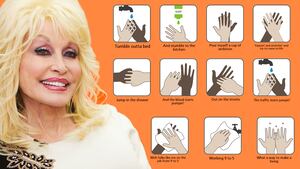One of the studies that the Trump administration is relying on as it moves ahead with plans to reopen the U.S. economy warns that even if states take the necessary steps to ease social distancing restrictions, counties across the country—both big and small—will see a significant spread of coronavirus.
The study, which was put together by PolicyLab at Children’s Hospital of Philadelphia, is in the hands of top coronavirus task force officials and people working with the team, sources confirmed to The Daily Beast. It projects that if officials move too quickly and too aggressively to reopen in mid May, individual counties could witness hundreds, if not a thousand-plus, more coronavirus cases reported each day by August 1. Just two weeks more social distancing, the study projects, could reduce infections substantially—with potentially hundreds of thousands of fewer cases if the projections are conservatively expanded out to all 3,000-plus counties across the country.
The modeling shows that those counties exist in various parts of the country, in both urban and rural communities. In almost all cases, counties would see notably fewer cases per day if they waited to ease social distancing restrictions until June 1, according to the study’s projections. The model also suggests that states moving to ease restrictions should consider allowing individual counties to craft their own policies. Under the projections, one county could experience significantly different daily case numbers than others in the state—even those nearby—merely by continuing to adhere to social distancing protocols.
“There’s going to be transmission if people stop sheltering in place,” Dr. Rubin, the director of PolicyLab at Children's Hospital of Philadelphia, said in an interview. “It’s not that all [counties] are safe to reopen. Every area is extremely sensitive to the amount of distancing you’re doing. The more cautious you are the better.”
Two administration officials who have seen the PolicyLab study say it is one of the few being seriously considered by the Trump coronavirus task force and that the White House is using it to inform how they advise governors on easing social distancing restrictions. One other official said it is “one of a number of studies and data” that the administration is looking at in the process of safely reopening the country.
The study’s findings raise questions about the White House’s push to shift the focus of its coronavirus response away from combating and mitigating the disease and more towards managing it. In recent days, President Donald Trump has talked about reorienting his coronavirus task force towards reopening the economy and insisted that the shift in focus could happen without putting additional lives at risk.
The data put together by PolicyLab suggests it’s not quite so risk-free. The authors laid out a variety of projections, including what would happen if there was roughly 33 percent less social distancing than prior to the pandemic. Such a percentage decrease, they calculated, would represent people in the county going “roughly halfway back to normal travel (pre-epidemic) to non-essential businesses” like bars and gyms.
Under their projections, if starting on May 15 residents in Los Angeles county were to conduct 33 percent less social distancing, the coronavirus daily case count would jump from about 471 cases to 1,467 by August 1. Similarly, Illinois’s Cook County, where Chicago is located, would see daily coronavirus case numbers spike from 626 to 2,494 between May 15 and August 1.
Among officials working with the president’s coronavirus task force, projections like these have sparked fears that states will ignore warnings and move too quickly to completely reopen their economies, prompting coronavirus case numbers and related deaths to continue to rise. That’s already happening in states such as Kansas and Nebraska, according to publicly available data from the state’s health departments.
A similar study reported by The Washington Post and The New York Times this week shows the coronavirus daily case count surging as high as 200,000 by June 1. The report includes stamps from the Center for Disease Control, Department of Health and Human Services, and the Department of Homeland Security. But officials inside the administration have said the study was not vetted before release.
Unlike that study, Rubin’s study looks at the disease’s impact locally. His modeling case counts for individual counties as a way to show how smaller communities might begin to think about reopening.
“I think what people are taking from the study is that it is OK to have selective strategies for reopening,” Rubin said, adding that the study is still in progress and currently under peer review.
The study looks at the coronavirus epidemic across 260 counties throughout the country. The team used publicly available data to model how social distancing, population density, and daily temperatures affect the number and spread of coronavirus infections over time across a county. It accounts for population characteristics, such as age, health insurance status, and smoking prevalence and uses cellphone movement data to include factors related to social distancing.
The model illustrates four scenarios in which social distancing practice reduces from its current national average of 70 percent, back to either 50 percent or 33 percent. It also considers two options for reopening: May 15 or June 1.
If Cook County were to conduct 33 percent less social distancing (or, put another way again, bring its economy roughly halfway back to normal) starting on June 1, as opposed to May 15, it would see its daily case numbers go up to 701 by August 1 instead of 1,868. Los Angeles County would experience a similar phenomenon with its daily case numbers increasing up to 383 by August 1 if it were to bring its economy roughly halfway back to normal starting on June 1, instead of 1,467 if it did so from May 15.
The model identifies social distancing as the most important factor in reducing transmission, but does not take into account what happens when people start ramping up commuting or flying, Rubin said.
“The outcomes and the forecasts… transfer responsibility back to the individual and the businesses,” he said.
Three senior Trump administration officials acknowledged that the White House and the coronavirus task force have been working with doctors at Children’s Hospital in Philadelphia in drafting guidelines for reopening the country. One official said the task force is particularly interested in the study’s findings that rising temperatures appear to be reducing the risk for large second peaks of coronavirus cases during the summer in many locations. But Rubin says that will only be the case as long as states move forward with reopening cautiously.
“No place, including those more rural areas, is immune from the effects of this virus,” Rubin said. “Temperature alone is not going to solve the problem.
--With reporting by Asawin Suebsaeng








